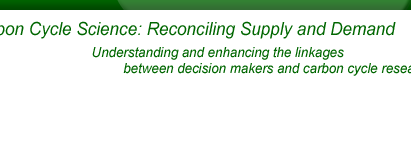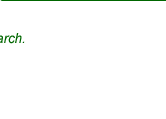 |
|
|
|
 |
|||||
|
|
|
|
|||||||
 |
|
|
|
|
|||||
 |
|||||||||
 |
|
|
|
|
Executive Summary
Carbon Cycle Science: Reconciling Supply and Demand
Understanding and enhancing the linkages between decision making and carbon cycle research
Background
The North American Carbon Program (NACP) research agenda seeks to improve our understanding of carbon cycling, including both sinks and sources of CO2 (and other greenhouse gases) in North America and in adjacent oceans. Carbon dioxide plays a central role in climate change and anthropogenic global warming. Recognizing this fact, the US Global Change Research Program (USGCRP) allocated about $200 million, or 13% of its $1.6 billion budget, to carbon cycle research in FY 2002. Findings from this research will ultimately be used to “inform future decisions on policies to reduce net emissions of CO2 and CH4, and to enhance sequestration of carbon through land management or by other means” (NACP p2).
The scientists who participate in the NACP research, and their research activities involved in carbon cycling, are what we describe as the ‘supply side’ of scientific information. Supply side activities range from understanding the impacts of soil conservation and tilling practices, to exploring the potential of injecting CO2 directly into deep saline aquifers. The ‘demand side’ represents the wide range of actors who will use the carbon sequestration science and information in decisions and with larger policy considerations. Actors range from the individual farmer, local governments and corporations to nations and international organizations. The amount and type of information that demand side actors find useful varies with how they will use the information. While the individual farmer may want information about the impact that low-till agricultural has on his productivity, the international community may be interested in knowing the net CO2 sequestration potential of low-till agricultural practices. In the economic marketplace, supply and demand are effectively linked, modulated, and optimized through many mechanisms. We argue that the same is true in the marketplace of scientific information.
One of the overarching goals of the NACP is to supply information that seeks to reduce uncertainties in carbon cycle science. Reducing scientific uncertainties, however, does not necessarily lead to good policy outcomes (as our research regarding extreme weather events shows) due in large part to weak linkages and poor communication between supply and demand sectors. To best inform decision makers, predictions must be understood not simply as a numeric product, but as a policy process, that includes three parallel and concurrent decision activities: research, communication and use. Recent research suggests that compatibility of scientific supply and decision maker demand can be increased through mechanisms that enhance knowledge of, and communication between, the supply and demand sectors. When scientists and decision makers understand each other’s capabilities, needs and limits, research agendas can be better designed to support decision making, and decisions can be more successfully rooted in scientifically robust information.
Missed Opportunity Matrix
One way to understand the supply/demand dynamics is to examine a particular decision setting in the context of our ‘Missed Opportunity Matrix’. In so doing, we ask two questions:
- Does the decision maker need information about the carbon cycle?
- Does the NACP target its research agenda on the information needs of the decision maker?
These two questions form, respectively, the ordinate and abscissa of our Missed Opportunity Matrix. Each of the four possible outcomes requires a unique focus from the standpoint of improving connections of supply and demand of carbon cycle science. For example, cases that involve decision makers who need information that the NACP is not providing requires different strategies for improved connections than a case where the NACP is providing scientific information that can inform decisions but that isn’t being used by decision makers. Use of the matrix will enable us to address several elements of the relation between the supply and demand side for carbon cycle science, including:
- The need to modify supply to address unmet demand-side needs for information
- The need to increase the receptivity of the demand side to existing or forthcoming scientific information that is potentially valuable but currently underutilized
- The need to identify new demand-side actors to take advantage of existing information that is currently underutilized
- The need for new processes of communication between demand and supply sides.
Purpose and Process
The purpose of this project is to map the supply and demand sides of carbon cycle research, assess the compatibility of supply and demand, and make concrete recommendations for enhancing future compatibility. The central question for our project is this:
How might carbon cycle research under the USGCRP more effectively and efficiently address the needs and capabilities of carbon cycle managers?
Subsidiary questions include:
- Who are the decision makers at whom carbon cycle research is aimed?
- What political options are available to specific classes of decision makers? What technical options are available?
- What are the actual information needs of carbon cycle managers?
- What are the likely policy-relevant outputs of carbon cycle research in the next five to ten years?
- Where are research agendas and decision maker needs well-aligned? Where are they mismatched?
- Where are the opportunities for increasing compatibility between research and decision making (either by modifying research agendas or modifying information demand)?
- How does communication between carbon cycle researchers and carbon managers now occur? How can it be enhanced?
Preliminary research will produce a series of background white papers to include: identification of supply and demand sectors; case studies representing each of the four possible outcomes from our ‘Missed Opportunity Matrix’; and lessons learned in both technology transfer and technology assessment in areas of science where connections to decision making are more mature. In the fall of 2004, we will host the Carbon Cycle Science: Reconciling Supply and Demand Workshop, bringing together actors representing both supply and demand sectors of carbon cycle research, research administrators, and policy analysts to discuss and debate the findings of the white papers and to develop a recommendation for a research agenda and institutional structure that would enhance and enable the ability of the NACP to effectively reconcile supply and demand for carbon cycle information.